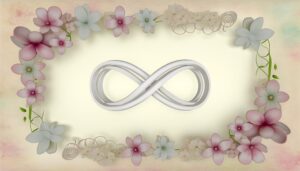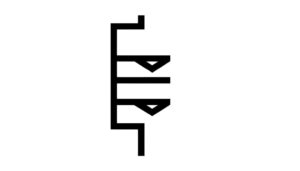What Is the Meaning of the Zia Symbol in Culture?
The Zia symbol, originating from the indigenous Zia Pueblo people of New Mexico, encompasses profound historical and cultural significance. Its sun design, with four groups of four rays, symbolizes life, growth, and time passage through connections to cardinal directions, seasons, times of day, and life stages.
Each quadrant symbolizes the interconnectedness of nature and human existence, stressing balance and harmony. The Zia symbol, now featured on the New Mexico state flag, continues to represent a blend of tradition and modernity.
This emblem remains a crucial part of both cultural heritage and contemporary identity, with deeper meanings awaiting exploration.
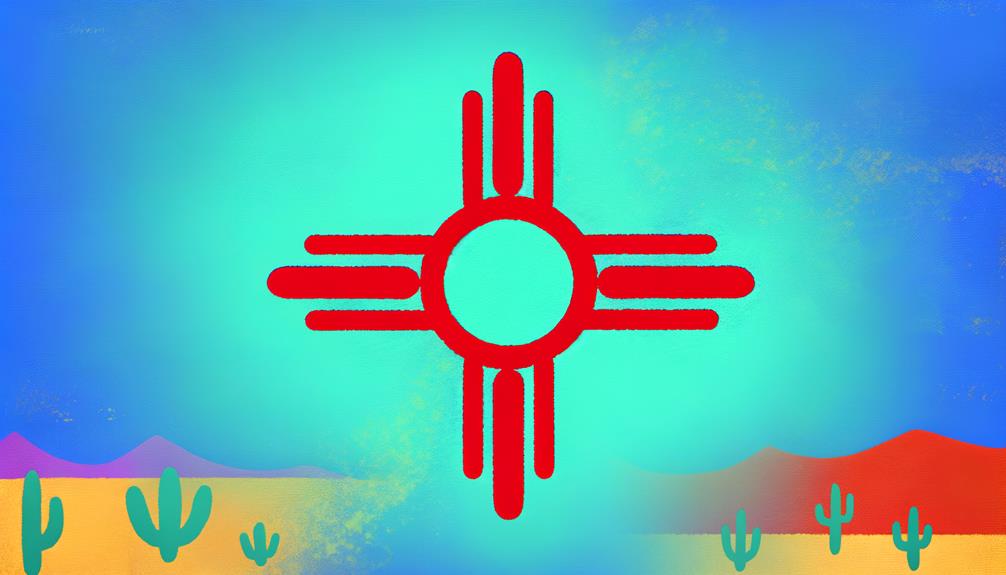
Key Takeaways
- The Zia symbol represents the sun, embodying life, growth, and the passage of time.
- Its four rays symbolize cardinal directions, seasons, times of day, and life stages.
- The symbol underscores balance, harmony, and respect for nature.
- It reflects the Zia Pueblo's sophisticated understanding of cosmology and their worldview.
- Modern uses include the New Mexico state flag and personal expressions, blending tradition with contemporary relevance.
Historical Origins
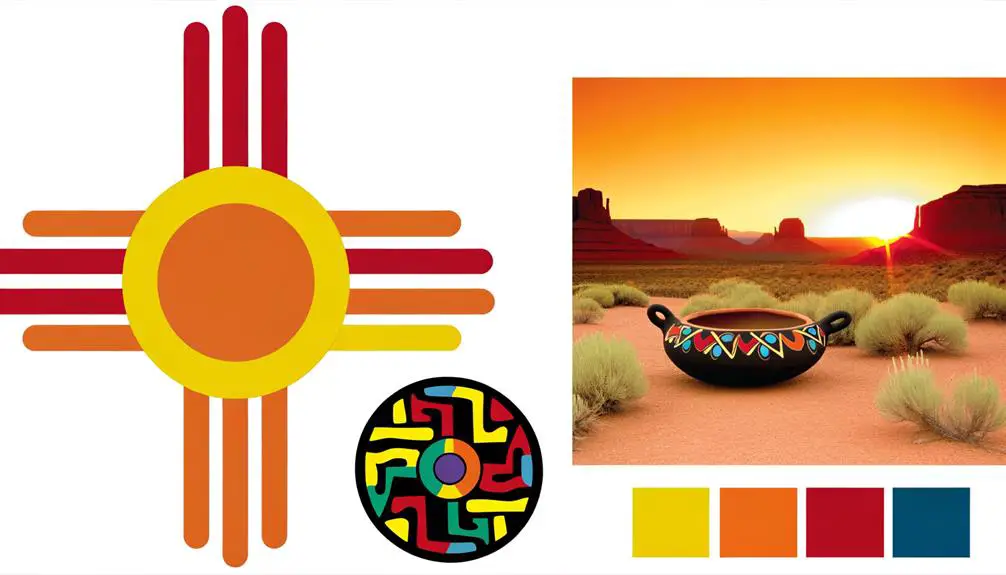
The Zia symbol, with its distinctive sun design, traces its historical origins back to the indigenous Zia Pueblo people of what is now New Mexico. Documented use of the symbol dates to pre-colonial times, where it was prominently featured in various forms of art and pottery.
The design consists of a central circle with four groups of four rays extending outward, embodying the Zia's profound connection to the sun. Archaeological findings suggest that the symbol was not merely decorative but also served integral roles in ceremonies and daily life.
This context underscores the symbol's enduring presence and its intricate role in the Zia Pueblo's historical narrative, reflecting a sophisticated understanding of cosmology and environmental factors.
Cultural Significance
The Zia symbol holds profound cultural significance, particularly within Native American heritage, where it epitomizes the sacred sun's role in life and spirituality.
This emblem, originating from the Zia Pueblo in New Mexico, encapsulates core elements of their worldview and cosmology.
Its representation of the sun underscores its importance in indigenous traditions and daily life, reflecting a broader cultural reverence for natural elements.
Native American Heritage
Embedded deeply in Native American heritage, the Zia symbol holds profound cultural significance for the Zia Pueblo people. Originating from the Zia tribe of New Mexico, the symbol embodies their beliefs and values, particularly those tied to the natural world and communal harmony.
The Zia people regard the symbol as sacred, with its fourfold symmetry representing:
- Four cardinal directions: North, South, East, West.
- Four stages of life: Childhood, youth, adulthood, old age.
- Four seasons of the year: Spring, summer, fall, winter.
These elements reflect a holistic worldview, emphasizing balance and unity.
The symbol's integration into various aspects of Zia life, from rituals to art, underscores its enduring relevance and the cultural continuity it provides to the Zia Pueblo community.
Symbolic Sun Representation
In addition to its fourfold symmetry, the Zia symbol's depiction of the sun carries profound cultural significance, reflecting the Zia Pueblo people's reverence for this central life force.
The sun is an essential element in Zia cosmology, symbolizing life, growth, and the passage of time. Each ray represents a principle of existence: the four cardinal directions, the four seasons, the four times of day, and the four stages of life.
This holistic representation underscores the interconnectedness of natural and human cycles. By embodying these concepts, the Zia symbol serves not merely as an artistic emblem but as a visual narrative of the Zia Pueblo's worldview, emphasizing balance, harmony, and respect for the natural world.
Symbolism of the Four Rays
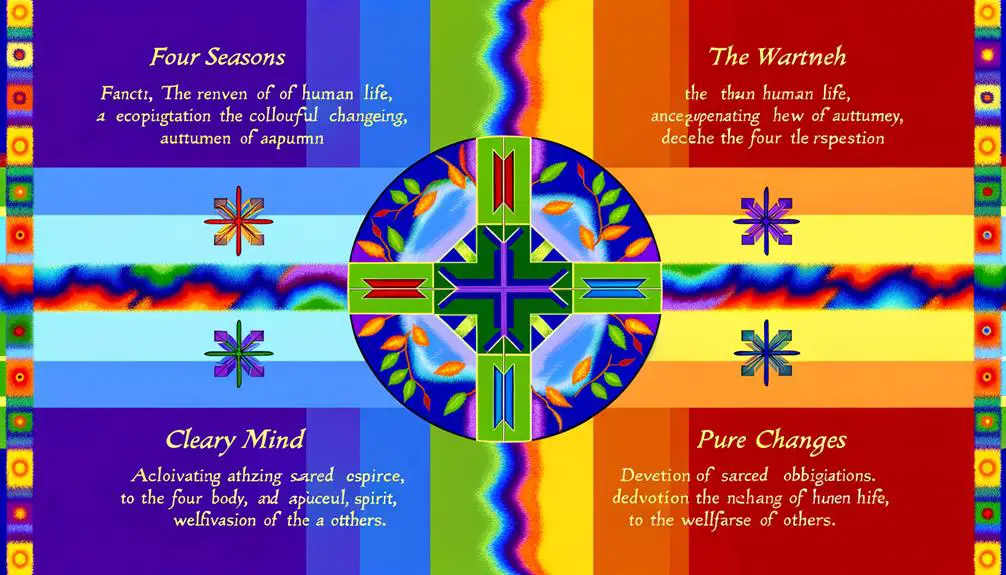
The four rays of the Zia symbol hold profound meaning, representing critical aspects of life and spirituality. Each ray signifies one of the Four Sacred Obligations, which are fundamental principles guiding personal conduct and community relations.
Additionally, the rays correspond to Life's Four Stages, encapsulating the journey from birth to old age, thereby providing a holistic view of the human experience.
Four Sacred Obligations
Central to the Zia symbol, the four rays extending from each quadrant represent the Four Sacred Obligations, which are fundamental principles in Zia culture. These obligations are deeply embedded in the Zia's worldview, guiding their interactions with the world and each other.
The Four Sacred Obligations encompass:
- Respect for Self: Emphasizing personal integrity and self-awareness.
- Respect for Others: Encouraging harmony and understanding within the community.
- Respect for Nature: Promoting a symbiotic relationship with the environment.
These principles underscore a holistic approach to life, reflecting a balance between individual responsibilities and communal harmony. Each obligation is integral to maintaining cultural continuity and ensuring a respectful existence within the natural world, affirming the Zia's philosophical and ethical framework.
Life's Four Stages
Representing the cyclical nature of human existence, the four rays of the Zia symbol also denote Life's Four Stages: childhood, youth, adulthood, and elderhood.
Each stage embodies distinct characteristics and responsibilities. Childhood is marked by learning and dependency, youth by exploration and growth, adulthood by responsibility and productivity, and elderhood by wisdom and legacy.
This segmentation underscores the Zia's holistic view of life, where each phase is interconnected and equally significant. The symbolism emphasizes the importance of balance and harmony throughout one's life journey.
Representation of Seasons
Within the Zia symbol, the four-fold division of lines is often interpreted as a representation of the four seasons. This interpretation aligns with the Zia's holistic view of life, where natural cycles are fundamental.
Each segment symbolizes one of the four seasons:
- Spring: A period of renewal and growth, symbolizing new beginnings.
- Summer: Representing maturity and abundance, reflecting the peak of life's activities.
- Autumn: A time for harvest and reflection, indicating the collection of life's rewards.
This cyclical perspective underscores the Zia's recognition of nature's rhythms and their integral role in human existence.
Understanding these seasonal representations provides insight into the Zia culture's respect for the interconnectedness of life and nature. This symbolism offers a profound appreciation for the natural world's cyclical patterns.
Directional Meanings
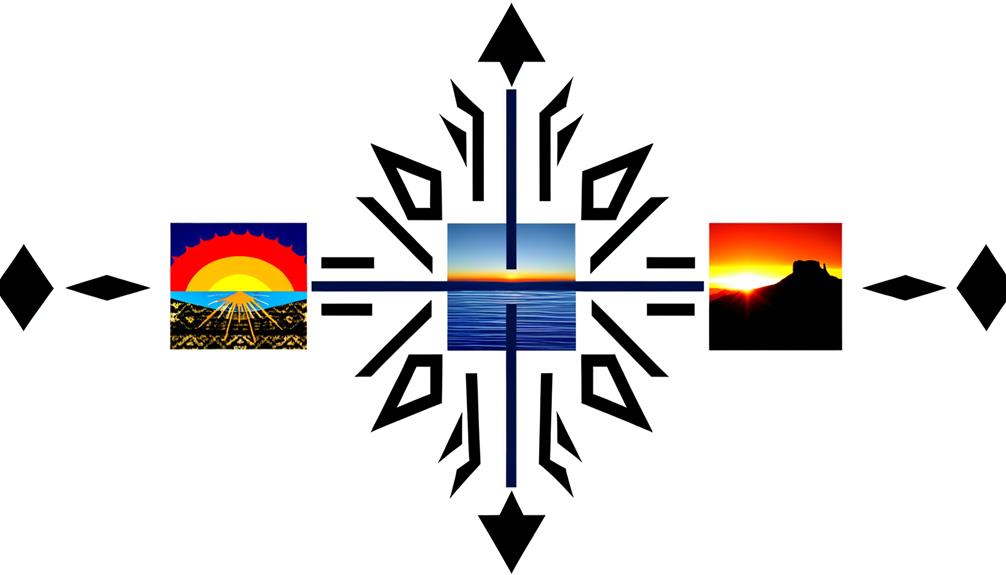
The Zia symbol's directional meanings encapsulate the cultural and spiritual significance attributed to the four cardinal directions in Zia cosmology. Each direction—north, south, east, and west—holds distinct interpretations and values.
For instance, the east is often associated with beginnings, enlightenment, and renewal, symbolizing the dawn of new opportunities.
The west, conversely, represents completion and introspection, akin to the setting sun.
The north is linked to wisdom and endurance, often reflecting the harsh, yet instructive, aspects of life.
The south embodies growth and vitality, resonating with warmth and abundance.
These directional meanings are not merely geographical but are deeply interwoven with the Zia's worldview, illustrating a holistic connection between the natural and spiritual domains.
Times of Day
Just as the Zia symbol's directional meanings encapsulate the cultural and spiritual significance of the cardinal points, its representation of the times of day—dawn, midday, dusk, and night—reflects a similar depth of interpretation and significance within Zia cosmology.
Each time of day holds specific symbolic meanings:
- Dawn: Signifies new beginnings and potential, embodying the promise of a new day.
- Midday: Represents the peak of activity and energy, often associated with the zenith of human endeavors.
- Dusk and Night: Together, they symbolize reflection, rest, and the cyclical nature of time, highlighting the importance of balance and renewal.
Understanding these elements enhances the appreciation of the Zia symbol's holistic portrayal of life's rhythms.
Life Stages
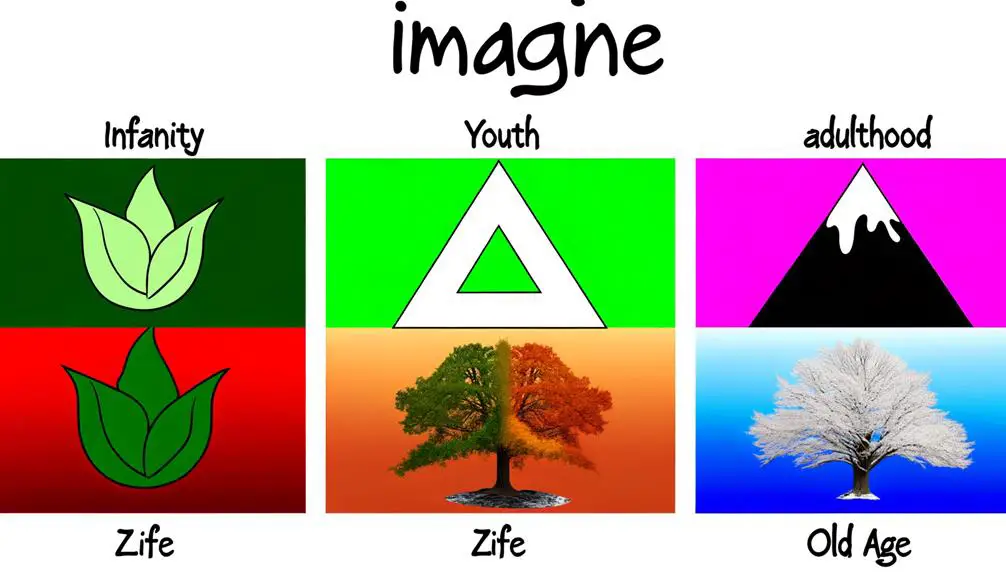
Life stages, as depicted by the Zia symbol, encapsulate the profound and interconnected phases of human existence, reflecting the cultural values and philosophical beliefs of the Zia people. The symbol's fourfold symmetry represents the progression through life's key stages, each imbued with its own significance.
| Life Stage | Description |
|---|---|
| Infancy | A period of growth and dependency, foundation. |
| Youth | Time of learning, exploration, and development. |
| Adulthood | Phase of responsibility and societal roles. |
| Old Age | Reflection, wisdom, and preparation for legacy. |
Each stage is respected and seen as essential to a balanced life, underscoring the Zia's holistic view of existence where every phase contributes to the individual's overall journey.
Modern Interpretations
Examining the modern interpretations of the Zia symbol reveals its evolving significance in contemporary contexts, bridging traditional values with modern identity. This adaptation is evident in various facets of society, reflecting both respect for its origins and the infusion of new meanings.
The Zia symbol today is often used to represent:
- State Identity: Prominently featured on the New Mexico state flag, it signifies unity and cultural pride.
- Commercial Usage: Incorporated in branding and logos, it embodies a blend of heritage and modernity.
- Personal Expression: Adopted in tattoos and personal adornments, it reflects individual connections to cultural roots.
These modern applications highlight the Zia symbol's dynamic role, preserving its historical essence while embracing contemporary relevance.
Conclusion
In summation, the Zia symbol, with its profound historical origins and rich cultural significance, transcends mere aesthetics to embody a complex tapestry of meanings.
The symbolism of its four rays intricately represents the seasons, cardinal directions, times of day, and life stages, encapsulating a holistic worldview.
Modern interpretations continue to honor and reinterpret these layers, ensuring the Zia's enduring legacy.
The emblem serves as a timeless evidence to the interconnectedness of existence and the cyclical nature of life.

